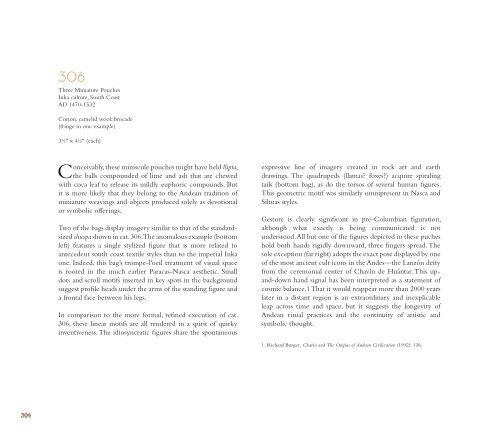You also want an ePaper? Increase the reach of your titles
YUMPU automatically turns print PDFs into web optimized ePapers that Google loves.
306<br />
Three Miniature Pouches<br />
Inka culture, South Coast<br />
AD 1470-1532<br />
Cotton, camelid wool; brocade<br />
(fringe in one example)<br />
3½" x 4½" (each)<br />
Conceivably, <strong>the</strong>se miniscule pouches might have held llipta,<br />
<strong>the</strong> balls compounded of lime and ash that are chewed<br />
with coca leaf to release its mildly euphoric compounds. But<br />
it is more likely that <strong>the</strong>y belong to <strong>the</strong> Andean tradition of<br />
miniature weavings and objects produced solely as devotional<br />
or symbolic offerings.<br />
Two of <strong>the</strong> bags display imagery similar to that of <strong>the</strong> standardsized<br />
chuspa shown in cat. 306. The anomalous example (bottom<br />
left) features a single stylized figure that is more related to<br />
antecedent south coast textile styles than to <strong>the</strong> imperial Inka<br />
one. Indeed, this bag’s trompe-l'oeil treatment of visual space<br />
is rooted in <strong>the</strong> much earlier Paracas-Nasca aes<strong>the</strong>tic. Small<br />
dots and scroll motifs inserted in key spots in <strong>the</strong> background<br />
suggest profile heads under <strong>the</strong> arms of <strong>the</strong> standing figure and<br />
a frontal face between his legs.<br />
In comparison to <strong>the</strong> more formal, refined execution of cat.<br />
306, <strong>the</strong>se linear motifs are all rendered in a spirit of quirky<br />
inventiveness. The idiosyncratic figures share <strong>the</strong> spontaneous<br />
expressive line of imagery created in rock art and earth<br />
drawings. The quadrupeds (llamas? foxes?) acquire spiraling<br />
tails (bottom bag), as do <strong>the</strong> torsos of several human figures.<br />
This geometric motif was similarly omnipresent in Nasca and<br />
Sihuas styles.<br />
Gesture is clearly significant in pre-Columbian figuration,<br />
although what exactly is being communicated is not<br />
understood. All but one of <strong>the</strong> figures depicted in <strong>the</strong>se puches<br />
hold both hands rigidly downward, three fingers spread. The<br />
sole exception (far right) adopts <strong>the</strong> exact pose displayed by one<br />
of <strong>the</strong> most ancient cult icons in <strong>the</strong> <strong>Andes</strong>—<strong>the</strong> Lanzón deity<br />
from <strong>the</strong> ceremonial center of Chavín de Huántar. This upand-down<br />
hand signal has been interpreted as a statement of<br />
cosmic balance.1 That it would reappear more than 2000 years<br />
later in a distant region is an extraordinary and inexplicable<br />
leap across time and space, but it suggests <strong>the</strong> longevity of<br />
Andean ritual practices and <strong>the</strong> continuity of artistic and<br />
symbolic thought.<br />
1 Richard Burger, Chavín and The Origins of Andean Civilization (1992): 136.<br />
304







